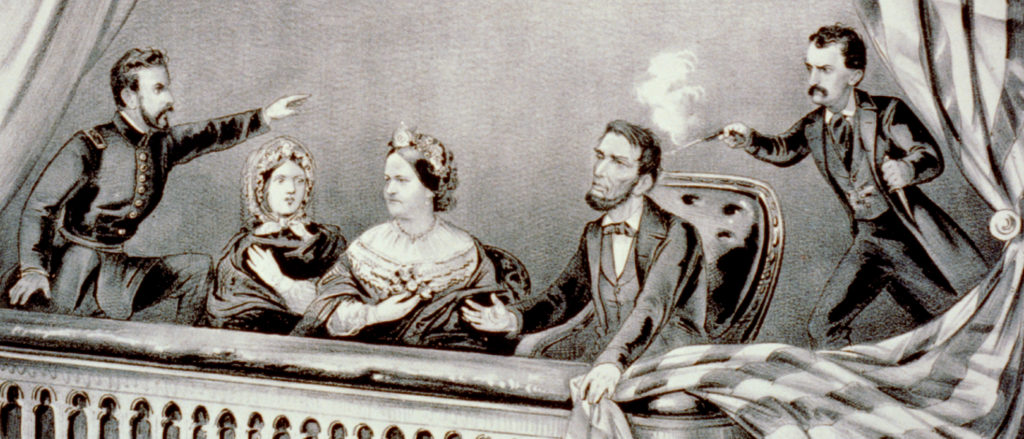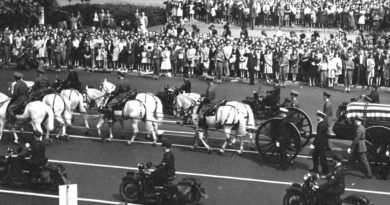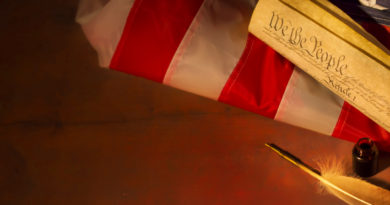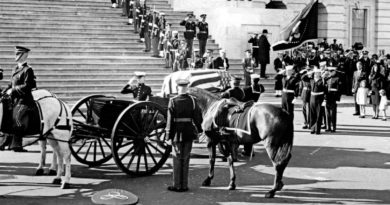5 Things About Lincoln’s Funeral You Might Not Know

April 14th, 1865″ by Currier & Ives, 1865. Photo courtesy of U.S. Library of Congress
Despite the passage of more than 150 years since his assassination and burial (on April 14 and May 4, 1865, respectively), Abraham Lincoln remains one of the most iconic presidents in U.S. history. And while most of us learn a great deal about Honest Abe in school, here are five facts about President Abraham Lincoln’s funeral and burial you might not know.
1. Lincoln Rode His Official Presidential Train Just Once
While U.S. presidents now travel in the state-of-the-art airplane designated Air Force One, President Abraham Lincoln had to settle for slower methods, such as horses and horse-drawn carriages. In February 1865, however — a mere two months before his assassination — the government completed construction of President Lincoln’s official railway train, the United States.
Replete with “elaborately painted and gilded wood and etched glass, and wheels designed to accommodate tracks of varying gauges” (because railway gauges, i.e., the width between tracks, weren’t yet standardized), the United States was intended to serve as Lincoln’s speedy, high-tech office on wheels.
Unfortunately, President Lincoln never rode in this train while living; instead, it only served as his funeral coach during a 13-day journey that carried his body from Washington, D.C., to Springfield, Illinois.
2. Lincoln’s Embalmed Body was Often “Touched Up”
The process of using chemicals to temporarily preserve corpses gained significant national attention during the U.S. Civil War when Thomas Holmes made a name for himself as a New York coroner’s physician who was investigating the embalming process.
In fact, Mary Lincoln, the president’s wife, viewed the body of Colonel Elmer E. Ellsworth — Abraham Lincoln’s friend and the first person of rank killed during the Civil War — in the White House in 1861 after Holmes embalmed Ellsworth. At the time, Washington, D.C., newspapers widely reported “favorable” results of this embalming, and demand for Holmes and his preservative process grew.
Perhaps because of Holmes’ direct connection to the Lincolns, as well as the notoriety surrounding his embalming process, President Lincoln’s body was embalmed as a preservation measure before his 13-day, 1,654-mile (2,662-kilometer) train journey from Washington, D.C., to Springfield, Illinois.
During the many stops made along the way, Lincoln’s body was “touched up” several times. More than 150 years later, however, debate still rages whether these touch-ups involved re-embalming his corpse, re-applying cosmetics to his face, or some combination of both.
One thing is certain: When Lincoln’s corpse was exhumed and examined 36 years later, “Mr. Lincoln’s features were totally recognizable.” (See below for more on Lincoln exhumations.)
3. Blacks Were Banned from Lincoln’s Funeral Procession
The U.S. Civil War arose, primarily, from the divide caused by the abomination of human slavery in the United States. Despite President Lincoln’s “Emancipation Proclamation” on January 1, 1863, which freed slaves in states rebelling against the United States and authorized black men to serve in the Union Army and Union Navy; despite the abolition of slavery by the U.S. Congress less than three months before Lincoln’s assassination, via the 13th Amendment; and despite a bloody, protracted war between the states that probably cost more than 750,000 American lives, the concept of freedom for all still failed to take hold.
In fact, municipal authorities in New York banned African-Americans from participating in President Lincoln’s funeral procession in anticipation of the funeral train stopping there on April 24, 1865.
Outraged upon learning of this, Lincoln’s secretary of war, Edwin Stanton, countermanded this ban but it was too late: instead of more than 5,000 blacks marching in sympathy for the slain president, only a “couple of hundred African Americans brought up the very rear.”
4. Criminals Tried to Kidnap Lincoln’s Corpse
Roughly 18 months after the burial of President Lincoln in the Oak Ridge Cemetery in Springfield, Illinois, a criminal named Terrence Mullins concocted a scheme to kidnap the president’s body and ransom it for $200,000. After enlisting the help of Jack Hughes and Lewis Swegles, the trio hid in the cemetery the night of November 7, 1866, and awaited their chance.
Unfortunately for them, just about everything that could go wrong did so. First, none of the three could pick the lock on the iron gate separating them from Lincoln’s marble sarcophagus, so Mullins attempted to saw through the padlock using a hacksaw. In his haste, he broke the blade and therefore had to use a file, which took much longer.
Second, after gaining entrance, the men struggled to remove the heavy lid of Lincoln’s sarcophagus, further delaying them.
Finally, after exposing the ornate black-and-silver coffin housing the president’s remains, the third and most significant flaw in their body-snatching attempt surfaced: Gang-member Swegles was actually an undercover agent of the U.S. Secret Service assigned to keep an eye on Hughes. (Moreover, more agents were also onsite in Oak Ridge Cemetery that night in anticipation of the kidnapping attempt!)
Despite this, Mullins and Hughes somehow still managed to escape but were eventually arrested and sent to jail for their body-snatching attempt.
5. Lincoln’s Corpse was Viewed Five Times After His Burial
Because of the unsuccessful body-snatching attempt described above, as well as repairs necessitated over time due to the decay of Lincoln’s tomb in the Oak Ridge Cemetery, the president’s surviving son, Robert, decided in 1901 that a more permanent method of protecting his father’s mortal remains was required to both thwart future kidnapping efforts and to better honor the president.
Thus, workers constructed a new tomb for President Lincoln’s remains that included enclosing his coffin in a metal cage (known as a mortsafe) buried 10-feet deep before pouring tons of concrete into the hole, permanently sealing Abraham Lincoln’s corpse.
Because of the forever-nature of this method and fears that Lincoln’s body had in fact already been stolen, however, authorities decided to open Lincoln’s coffin and view the remains. Therefore, on September 26, 1901, two men “chiseled an oblong piece out of the top of the lead-lined coffin,” exposing the remains.
More than 20 people viewed Abraham Lincoln’s remains, which, despite his burial 36 years earlier, still wore “a melancholy expression, but his black chin whiskers hadn’t changed at all.” The “wart” on Lincoln’s cheek remained, and all 23 people agreed that the remains in the coffin were, in fact, those of President Lincoln.
While this was the last time anyone viewed Lincoln’s corpse, the president’s remains were probably viewed on four previous occasions after his death (not including the multiple “touch-ups” he received during his funeral procession, described above) — including the first viewing on December 21, 1865, just seven months after Lincoln’s burial.
Sources:
“How Abraham Lincoln’s Funeral Train Journey Made History” by Adam Goodheart, April 18, 2015. National Geographic. Retrieved January 5, 2019. http://news.nationalgeographic.com/2015/04/150418-abraham-lincoln-funeral-train-railroad-civil-war-history
The History of American Funeral Directing by Robert Habenstein and William Lamers, 9th ed., 2018, National Funeral Directors Association of the United States, Inc.
“Abraham Lincoln’s Body Exhumed and Viewed in 1901.” http://rogerjnorton.com. Retrieved January 5, 2019. http://rogerjnorton.com/Lincoln13.html
“Recounting the Dead” by J. David Hacker, September 20, 2011. The New York Times. Retrieved January 5, 2019. http://opinionator.blogs.nytimes.com/2011/09/20/recounting-the-dead/#more-105317
“The Attempted Abduction of Abraham Lincoln’s Body” by George Cashman, May 1, 1965. Illinois State Register. Retrieved January 5, 2019. http://genealogytrails.com/ill/stealinglincoln.htm




